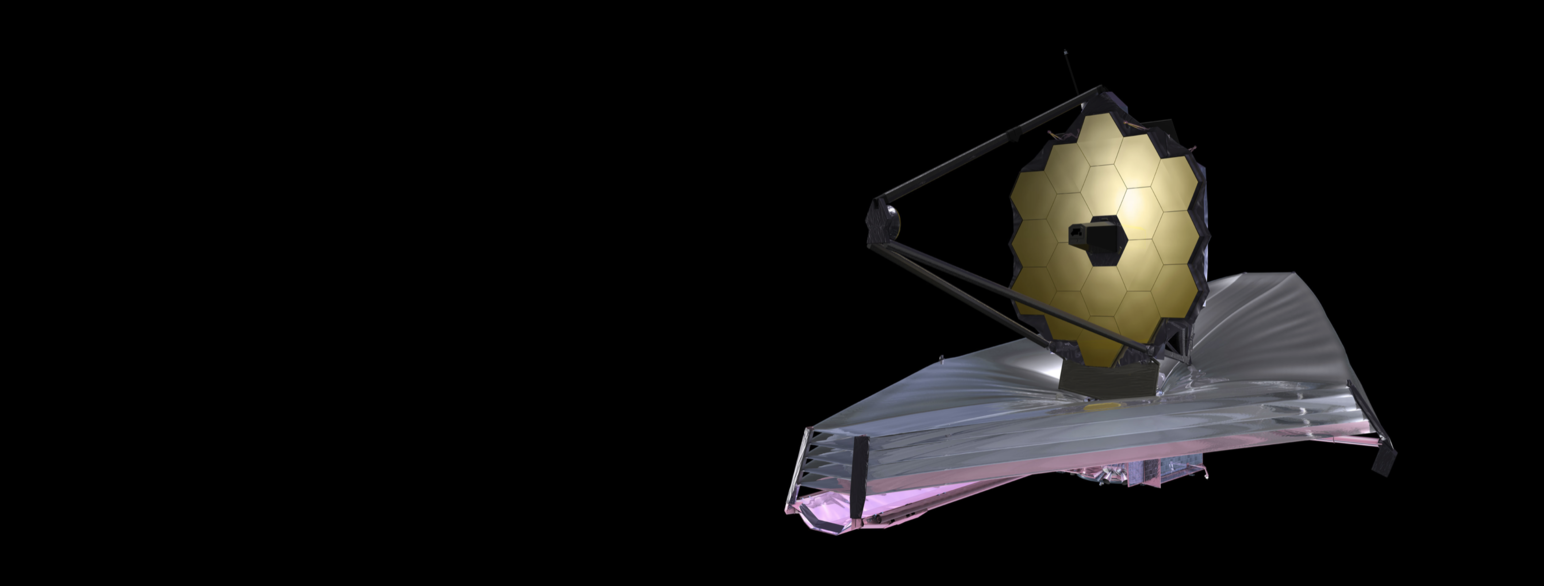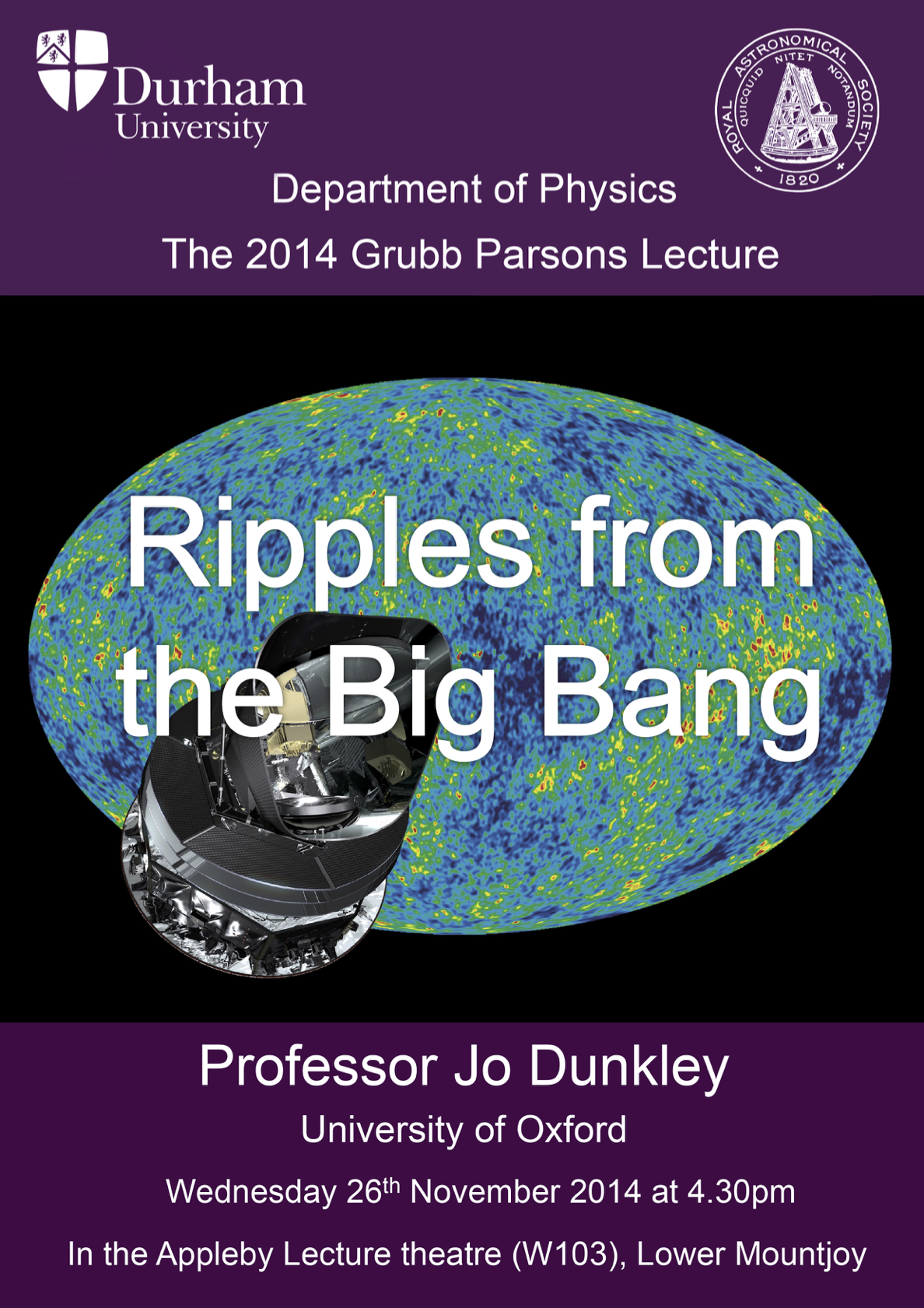Grubb Parsons Lecture archive
2023/24
| Title of the talk | |
|---|---|
|
|
The James Webb Space Telescope |
| Speaker | |
| Prof Gillian Wright CBE (UK ATC, Edinburgh) | |
| Description | |
| Prof Gillian Wright is the European Project Scientist for the MIRI Instrument on the JWST that allows us to analyse the light from stars formed within 300 million years after the Big Bang. | |
| About the Speaker | |
2023
| Title of the talk | |
|---|---|
|
|
The Event Horizon Telescope - Imaging Black Holes |
| Speaker | |
| Prof. Heino Falcke (Radboud University, NL) | |
| Description | |
| The inside of black holes is shielded from observations by an event horizon, a virtual one-way membrane through which matter, light and information can enter but never leave.
Does such an event horizon really exist? Can one see it? In 2019 the Event Horizon Telescope made the first ever image of a black hole. The speaker was one of the pioneers of this experiment and the talk will review the results of the Event Horizon Telescope, its scientific implications, and future developments. |
|
| About the Speaker | |
2017/18
| Title of the talk | |
|---|---|
|
|
The Square Kilometre Array: Probing the Universe from the Dawn of Time to the Origins of Life |
| Speaker | |
| Professor Philip Diamond (SKA Director-General) | |
| Description | |
|
The Square Kilometre Array will be the world’s largest and most sensitive radio telescope. The total collecting area will be approximately one square kilometre giving 50 times the sensitivity, and 10,000 times the survey speed, of the best current-day telescopes. The SKA will be built in Southern Africa and in Australia. Thousands of receptors will extend to distances of up to 3 000 km from the central regions. The SKA will address fundamental unanswered questions about our Universe including how the first stars and galaxies formed after the big bang, how dark energy is accelerating the expansion of the Universe, the role of magnetism in the cosmos, the nature of gravity, and the search for life beyond Earth. The target construction cost is €1,500 million and construction of Phase one of the SKA is scheduled to start in 2016. The SKA Organisation, with its headquarters in Manchester UK, was established in December 2011 as a not-for-profit company in order to formalise relationships between the international partners and centralise the leadership of the project. |
|
| About the Speaker | |
|
Professor Diamond has 30 years’ experience in the field of radio astronomy and a long standing involvement in the Square Kilometre Array radio telescope project. Previously he served as Chief of CSIRO Astronomy and Space Science (CASS) organisation in Australia. He has worked as a professional astronomer in five countries (UK, Sweden, Germany, USA and Australia) and has also served as Director of the Jodrell Bank Centre for Astrophysics. During his time in Australia, Prof. Diamond directed the operation of two major facilities: the Australia Telescope National Facility (ATNF: comprising Parkes Observatory, the Australia Telescope Compact Array and the Mopra telescope) and the Canberra Deep Space Communications Complex (CDSCC) at Tidbinbilla, part of NASA’s Deep Space Network. In addition, he was responsible for the team designing and constructing ASKAP, the Australian SKA Pathfinder, currently being built in Western Australia. He first became involved in the SKA in 2000, shortly after his return to the UK from 12 years at the NRAO in the USA, when he organised one of the early meetings of the International SKA Steering Committee (ISSC). Since that time, he has been heavily involved in various SKA activities. He was one of the longest-serving members of the ISSC, which later became the SSEC, and chaired the committee in 2005/6. |
|
2016
| Title of the talk | |
|---|---|
|
|
The Awesome Birth of Gravitational Wave Astronomy |
| Speaker | |
| Prof. Bernard Schutz | |
| Description | |
| On 14 September 2015 the two LIGO detectors registered an exceptionally strong gravitational wave signal, which turned out to come from two unexpectedly massive black holes at a distance of more than 400 Mpc, merging to form a single one and radiating three solar masses of energy in the process. In this talk, Prof Schutz explained how this detection was made and what its implications are for astrophysics, and the future prospects for this infant branch of astronomy. | |
| About the Speaker | |
|
For almost 20 years, Prof. Bernard Schutz played a key role in the international success of the Max Planck Institute for Gravitational Physics, being instrumental in revitalising research into applying Einstein's theory of general relativity in astrophysics.
At the Albert Einstein Institute, Prof. Schutz led the Astrophysical Relativity department. His work in theoretical astrophysics - studies on theoretical calculations of gravitational wave signals, and the development of methods for analysing gravitational wave signals – have made him one of the internationally leading experts in the field of general relativity research.
Prof. Schutz was awarded the Amaldi Gold Medal of the Italian Society of General Relativity and Gravitation. He is an Hononary Fellow of the Royal Astronomical Society, a Fellow of the International Society for General Relativity and Gravitation and a Fellow of the American Physical Society as well as the Institute of Physics in the UK. He also received an honorary Doctorate of Science from Glasgow University.
Presently Director of the Data Innovation Institute at Cardiff University, he is the Principal Investigator responsible for data analysis for the GEO600 collaboration - part of the LIGO Scientific Collaboration - and a member of the eLISA Science Team guiding the development of the ESA mission to place a gravitational wave detector in space. eLISA is currently approved for launch in 2034-6. |
|
2015
| Title of the talk | |
|---|---|
 |
To Catch a Comet! |
| Speaker | |
| Professor Mark McCaughrean (European Space Agency) | |
| Description | |
| Professor Mark McCaughrean described the scientific motivation for the Rosetta mission, its history, and the discoveries that have been made in the past year since this first ever rendezvous with, escorting of, and landing on a comet. Rosetta mission arrived at Comet 67P/Churyumov-Gerasimenko in August 2014, returning spectacular images of this remarkable dark, dusty, icy remnant of the birth of our Solar System. In the following year, the Rosetta team have studied and surveyed the comet in detail, including the exciting deployment of the Philae lander to its surface on 12 November 2014, under the gaze of worldwide attention. | |
| About the Speaker | |
| Prof Mark McCaughrean works for the European Space Agency, where he is the Senior Scientific Advisor in the Directorate of Science and Robotic Exploration, responsible for communicating the scientific results from ESA's astronomy, heliophysics, planetary, and fundamental physics missions. Following his PhD from the University of Edinburgh in 1988, he has worked in the UK, the US, Germany, and the Netherlands. His personal research involves observational studies of the formation of stars and their planetary systems using state-of-the-art ground- and space-based telescopes. He is an Interdisciplinary Scientist on the Science Working Group for the NASA/ESA/CSA James Webb Space Telescope. | |
2014
| Title of the talk | |
|---|---|
|
|
Ripples from the Big Bang |
| Speaker | |
| Professor Jo Dunkley | |
| Description | |
|
By looking far out into space, we can see back almost to the dawn of time. Faint microwave light is reaching us now that set off on its journey almost 14 billion years ago. It carries a picture of what the Universe looked like back then, and helps us find out how galaxies like our own Milky Way came to be here billions of years later.
It also helps us discover what was happening at the Big Bang itself. In her lecture, Professor Dunkley talked about the space satellites and telescopes at the South Pole and in Chile that are being used to study this light, and what we are learning from them about the beginning of the Universe. |
|
| About the Speaker | |
|
Jo Dunkley is a Professor of Astrophysics at the University of Oxford. Her research is in cosmology, studying the origins and evolution of the Universe, and Jo teaches undergraduate and graduate physics students. She was awarded the Maxwell Medal and the Fowler Prize for work on the Cosmic Microwave Background. |
|
2013
| Title of the talk | |
|---|---|
 |
The European Extremely Large Telescope: A new giant for the next decade and beyond |
| Speaker | |
| Professor Isobel Hook | |
| Description | |
|
The European Extremely Large Telescope (E-ELT) is a future ground-based optical and infrared telescope. With a primary mirror diameter of 39m, it will be the largest optical-infrared telescope in the world when it enters operation in the middle of the next decade.
Construction work is underway at the telescope site in Chile. In this talk Isobel discusses some highlights from the science case for the E-ELT, which ranges from studies of exo-planets to the most distant galaxies and cosmology. She describes the telescope design and plans for the instrumentation suite, before discussing the current status of the project. |
|
| About the Speaker | |
|
Professor Isobel Hook is from the University of Oxford and INAF - Observatory of Rome. As the Chair of the E-ELT Science Working Group and a current member of the E-ELT Project Science Team, Isobel Hook has been central to the development of the most ambitious project ever attempted by European astronomers. |
|
2012
| Title of the talk | |
|---|---|
|
|
The Herschel Space Observatory: Exploring the Origins of stars and Galaxies |
| Speaker | |
| Professor Matt Griffin | |
| Description | |
|
The Herschel is a European Space Agency satellite launched in May 2009 to study the far infrared properties of the Universe. The satellite has performed well above expectations and has produced important results ranging from asteroids to the most distant galaxies. In his lecture, Professor Griffin will describe the scientific impact of Herschel and the future prospects for far infrared wavelength astronomy. |
|
| About the Speaker | |
|
Professor Matt Griffin is the Principle Investigator of the SPIRE instrument on the Herschel Space Observatory. |
|
2011
| Title of the talk | |
|---|---|
 |
Are we alone? |
| Speaker | |
| Dr Jill Tarter | |
| Description | |
|
Called "Are we alone?", the lecture explored the search for extraterrestrial intelligence and the prospects of finding it in the next few decades.
Aliens abound on the movie screens, but in reality we are still trying to find out if we share our universe with other sentient creatures. Intelligence is very difficult to define, and impossible to directly detect over interstellar distances.
Therefore, SETI is actually an attempt to detect evidence of another distant technology. If we find such evidence, we will infer the existence of intelligent technologists.
For the past 50 years, the SETI community has had a very pragmatic definition of intelligence - the ability to build large transmitters.
The majority of SETI searches to date have looked for radio signals coming from distant civilizations. We've recently begun looking for very short optical pulses as well. As our own technology matures and innovates, we may try other means of searching, and we will certainly improve upon the searches that we are already conducting. |
|
| About the Speaker | |
|
Dr Jill Tarter is from the Center for SETI (Search for Extraterrestrial Intelligence) in San Francisco, California. |
|


/prod01/prodbucket01/media/durham-university/departments-/physics/major-lecture-series/Hero-Header-bg-image.jpg)







